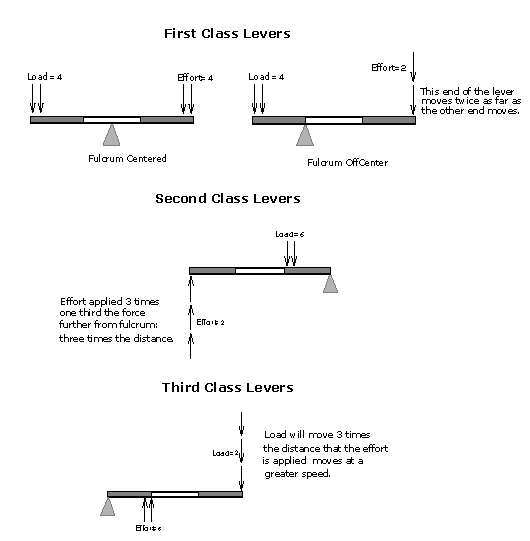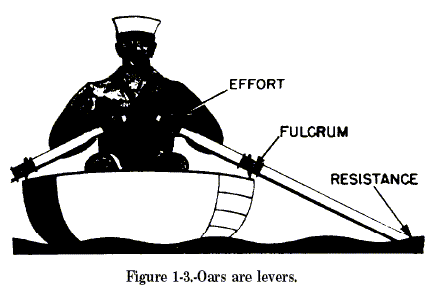A lever is a machine consisting of a beam or rigid rod pivoted at a fixed hinge, or fulcrum. It is one of the six simple machines identified by Renaissance scientists.
In this case, the power into the lever equals the power out, and the ratio of output to input force is given by the ratio of the distances from the fulcrum to the points of application of these forces. This is known as the law of the lever.
The mechanical advantage of a lever can be determined by considering the balance of moments or torque , T, about the fulcrum, where M1 is the input force to the lever and M2 is the output force.
The mechanical advantage of the lever is the ratio of output force to input force, This relationship shows that the mechanical advantage can be computed from ratio of the distances from the fulcrum to where the input and output forces are applied to the lever.
It is common to call the input force the effort and the output force the load or the resistance. This allows the identification of three classes of levers by the relative locations of the fulcrum, the resistance and the effort: Class 1: Fulcrum in the middle: the effort is applied on one side of the fulcrum and the resistance on the other side, for example, a crowbar or a pair of scissors .
These cases are described by the mnemonic "fre 123" where the fulcrum is in the middle for the 1st class lever, the resistance is in the middle for the 2nd class lever, and the effort is in the middle for the 3rd class lever.
If a and b are distances from the fulcrum to points A and B and let the force FA applied to A is the input and the force FB applied at B is the output, the ratio of the velocities of points A and B is given by a/b, so we have the ratio of the output force to the input force, or mechanical advantage, is given by This is the law of the lever, which was proven by Archimedes using geometric reasoning.
It shows that if the distance a from the fulcrum to where the input force is applied is greater than the distance b from fulcrum to where the output force is applied , then the lever amplifies the input force. On the other hand, if the distance a from the fulcrum to the input force is less than the distance b from the fulcrum to the output force, then the lever reduces the input force.
Thus, the ratio of the output force FB to the input force FA is obtained as which is the mechanical advantage of the lever. This equation shows that if the distance a from the fulcrum to the point A where the input force is applied is greater than the distance b from fulcrum to the point B where the output force is applied, then the lever amplifies the input force.
If the opposite is true that the distance from the fulcrum to the input point A is less than from the fulcrum to the output point B, then the lever reduces the magnitude of the input force. This is the law of the lever, which was proven by Archimedes using geometric reasoning.
In this case, the power into the lever equals the power out, and the ratio of output to input force is given by the ratio of the distances from the fulcrum to the points of application of these forces. This is known as the law of the lever.
The mechanical advantage of a lever can be determined by considering the balance of moments or torque , T, about the fulcrum, where M1 is the input force to the lever and M2 is the output force.
The mechanical advantage of the lever is the ratio of output force to input force, This relationship shows that the mechanical advantage can be computed from ratio of the distances from the fulcrum to where the input and output forces are applied to the lever.
It is common to call the input force the effort and the output force the load or the resistance. This allows the identification of three classes of levers by the relative locations of the fulcrum, the resistance and the effort: Class 1: Fulcrum in the middle: the effort is applied on one side of the fulcrum and the resistance on the other side, for example, a crowbar or a pair of scissors .
These cases are described by the mnemonic "fre 123" where the fulcrum is in the middle for the 1st class lever, the resistance is in the middle for the 2nd class lever, and the effort is in the middle for the 3rd class lever.
If a and b are distances from the fulcrum to points A and B and let the force FA applied to A is the input and the force FB applied at B is the output, the ratio of the velocities of points A and B is given by a/b, so we have the ratio of the output force to the input force, or mechanical advantage, is given by This is the law of the lever, which was proven by Archimedes using geometric reasoning.
It shows that if the distance a from the fulcrum to where the input force is applied is greater than the distance b from fulcrum to where the output force is applied , then the lever amplifies the input force. On the other hand, if the distance a from the fulcrum to the input force is less than the distance b from the fulcrum to the output force, then the lever reduces the input force.
Thus, the ratio of the output force FB to the input force FA is obtained as which is the mechanical advantage of the lever. This equation shows that if the distance a from the fulcrum to the point A where the input force is applied is greater than the distance b from fulcrum to the point B where the output force is applied, then the lever amplifies the input force.
If the opposite is true that the distance from the fulcrum to the input point A is less than from the fulcrum to the output point B, then the lever reduces the magnitude of the input force. This is the law of the lever, which was proven by Archimedes using geometric reasoning.





No comments:
Post a Comment